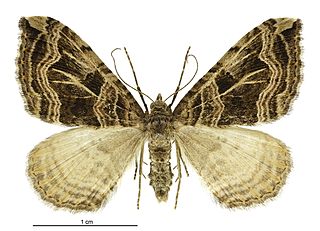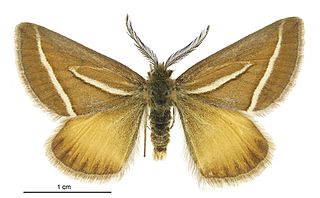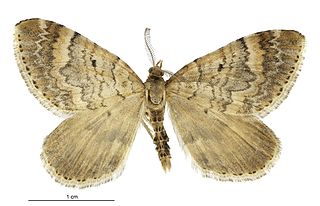
Hypocystina is a subtribe of butterflies.

The Satyrini is one of the tribes of the subfamily Satyrinae. It includes about 2200 species and is therefore the largest tribe in the subfamily which comprises 2500 species.

Xanthorhoe semifissata, commonly known as the barred pink looper. is a moth of the family Geometridae. It is endemic to New Zealand and is found throughout the country although it is much less common in the mountains in the south and west of the South Island. The larvae host plants include Nasturtium officinale as well as species in the Cardamine genus. Adult moths inhabit shrubs at the edge of native forest.

Helastia is a genus of moths in the family Geometridae erected by Achille Guenée. It is considered by some to be a synonym of Larentia. This genus was redefined and described in 1987 by Robin C. Craw. This genus is endemic to New Zealand.

Lycaena feredayi, the glade copper, is a butterfly of the family Lycaenidae. It is endemic to New Zealand.

Argyrophenga antipodum, the common tussock or tussock ringlet, is a species of butterfly commonly found in the South Island of New Zealand.

Helastia cinerearia is a moth of the family Geometridae. It is endemic to New Zealand and can be found in the North, South and Stewart Islands as well as on the Mercury and Chatham Islands. The preferred habitat of H. cinerearia includes urban gardens, various types of forest and sub alpine habitats. The larval host is lichen on rocks. The adult moths are on the wing all year round but are most commonly observed from September until February. Adult moths are nocturnal and have been observed feeding from and likely pollinating Hebe salicifolia, Hoheria lyallii and Leptospermum scoparium.

Aponotoreas insignis is a moth of the family Geometridae. It is endemic to New Zealand.

Xanthorhoe bulbulata is a species of moth in the family Geometridae. It is endemic to New Zealand. It is classified as critically endangered by the Department of Conservation.

Helastia expolita is a moth of the family Geometridae. This species is endemic to New Zealand and occurs in the Buller, Marlborough, North and Mid Canterbury regions.This species inhabits short tussock grassland in montane to subalpine zones. Adult moths are nocturnal but little is known about the life history of H. expolita. Adults have been observed on the wing in November. It has been hypothesised the larvae of H. expolita feed on the flowers of Helichrysum species and then feed on mosses, lichens or shrubs growing nearby. It is classified as "At Risk, Relict'" by the Department of Conservation.

Helastia siris is a moth of the family Geometridae. This species is endemic to New Zealand. It is classified as "At Risk, Relict'" by the Department of Conservation.

Paranotoreas fulva is a species of moth in the family Geometridae. This species is endemic to New Zealand and is found in the southern half of the South Island. The preferred habitat of this species are the salt pans of Otago, the mountainous grassland areas in South Canterbury and Otago and the glacial outwash terraces south of Tekapo. The larvae feed on Atriplex buchananii and Plantago coronopus. Adults are day flying and have been recorded as being on the wing in March, October and December. P. fulva is classified as "At Risk, Relict" by the Department of Conservation.

Notoreas chrysopeda is a species of moth in the family Geometridae. This species is endemic to New Zealand. It is a colourful day flying moth that lives in mountainous habitat.

Asaphodes declarata is a species of moth in the family Geometridae. This species is endemic to New Zealand and has been observed in the southern parts of the South Island. This species prefers open tussock grassland habitat amounts beech forest and in mountainous terrain. It can be found at altitudes of between 450 and 1750 m. The adults of this species are on the wing from November to March. The moths can vary both in size and, with the female of the species, in markings.

Asaphodes dionysias is a species of moth in the family Geometridae. This species is endemic to New Zealand and is only known from mountainous areas in Central Otago. It lives in open grassy mountainous habitat at altitudes up to 1750 m. It is also known to live in wetland habitat. The larvae of this species feed on native herbs. The adults of this species are on the wing in January and February. The adult female of the species has reduced wing size in comparison to the male.

Asaphodes oraria is a species of moth in the family Geometridae. This species is endemic to New Zealand and has been observed in the southern South Island and on Stewart Island / Rakiura. The male is pale yellow coloured and the female has severely reduced wings and is flightless. The habitat of this species is tussock grasslands on coastal sand dunes and in the mountains at elevations of approximately 4,000ft. The larvae have adapted to feeding on exotic lawn daisy species in the genus Bellis. The adults of this species are on the wing from November to April.

Asaphodes recta is a moth in the family Geometridae. It is endemic to New Zealand and is found in the southern parts of the South Island. The preferred habitat of this species is open tussock grassland. The adults are on the wing in February and March. Larvae of this species have been reared on species in the genera Ranunculus and Bellis.

Asaphodes sericodes is a moth in the family Geometridae. It is endemic to New Zealand and has been observed in the southern parts of the South Island. This species inhabits open tussock grasslands in subalpine scrub or wetlands. The female of the species is likely semi-apterous and is flightless. The adult males are on the wing in January.
Argyrophenga harrisi, also known as Harris's tussock or the Nelson tussock is a species of butterfly found in the northern parts of the South Island of New Zealand. It was first described by R. C. Craw in 1978.

Argyrophenga janitae, also known as Janita’s tussock is a species of butterfly found in the South Island of New Zealand. It was first described by R. C. Craw in 1978.



















